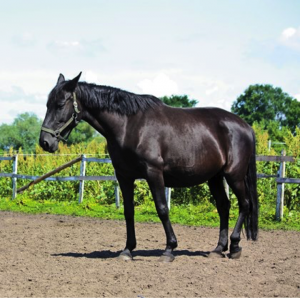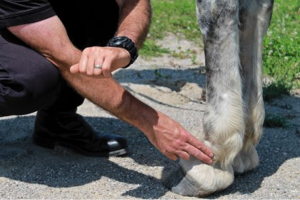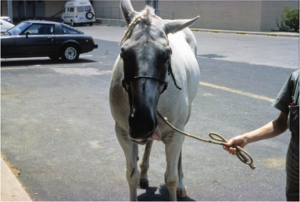Tick-Borne Disease: Tremendously Tricky in Horses
 Maps courtesy of Centers for Disease Control and Prevention; Tick photos courtesy of Mat Pound/USDA/Bugwood.org and Wikimedia Commons
Learn the latest on diseases horses can get from ticks and why they continue to frustrate veterinarians and researchers
If the sight of a tick makes your skin crawl—even if it’s not crawling on your skin— you’re not alone. That feeling is founded on more than a natural aversion to arachnids; diseases transmitted by ticks can pose a real health threat. With Centers for Disease Control and Prevention (CDC) maps outlining tick ranges throughout the majority of the United States, it’s important we brush up on our understanding of tick-borne diseases. In this article we’ll take a look at the three that pose the biggest risk to horses: Lyme disease, anaplasmosis, and piroplasmosis.
Lyme Disease
Horse owners living in areas of the country heavily infested with Ixodes scapularis, commonly known as blacklegged ticks (also referred to as deer ticks or bear ticks), know these parasites are more than a nuisance. In these regions contracting Lyme disease from infected ticks is entirely possible for horses and humans alike.
Lyme disease is a very difficult disease to prevent, diagnose, and treat in horses, says Linda Mittel, MSPH, DVM, senior extension associate at Cornell University’s Animal Health Diagnostic Center, in Ithaca, New York. Horses contract Lyme disease when the spirochete (a type of bacterium) Borrelia burgdorferi is transmitted through the bite of an infected tick.
“Signs of Lyme disease might not appear until 6 weeks after exposure”
Diagnosis Here’s why diagnosing Lyme disease is tricky: Not all infected horses exhibit clinical signs, and the signs themselves are often confounding, meaning they can point to any number of other diseases. Even if you know an infected tick bit your horse (You can actually test it!), signs of Lyme disease might not appear for up to six weeks after exposure. In short, nothing is straightforward with this disease. An infected tick might or might not transmit the bacteria to its host, and an infected animal might or might not exhibit signs of disease.
So while Lyme disease symptoms are not necessarily cut-and-dried, they can include low-grade fever, muscle tenderness, muscle wasting, weight loss, a stiff or uncoordinated gait, swollen joints, “shifting” lameness in various joints, lethargy, hyperesthesia (sensitivity to sound and touch), and uveitis (simply, inflammation of the vascular layer of the eye). While in private practice in the Northeast, Mittel often saw non-neurologic clinical signs of Lyme disease that included unexplained weight loss, changes in attitude and behavior, uveitis, and hypersensitivity. Some signs might arise from the bacterial infection itself, while others (e.g., uveitis) result from the body’s immune response to it. Lyme neuroborreliosis (NB), a rare condition, occurs when B. burgdorferi infects the horse’s nervous system.
Maps courtesy of Centers for Disease Control and Prevention; Tick photos courtesy of Mat Pound/USDA/Bugwood.org and Wikimedia Commons
Learn the latest on diseases horses can get from ticks and why they continue to frustrate veterinarians and researchers
If the sight of a tick makes your skin crawl—even if it’s not crawling on your skin— you’re not alone. That feeling is founded on more than a natural aversion to arachnids; diseases transmitted by ticks can pose a real health threat. With Centers for Disease Control and Prevention (CDC) maps outlining tick ranges throughout the majority of the United States, it’s important we brush up on our understanding of tick-borne diseases. In this article we’ll take a look at the three that pose the biggest risk to horses: Lyme disease, anaplasmosis, and piroplasmosis.
Lyme Disease
Horse owners living in areas of the country heavily infested with Ixodes scapularis, commonly known as blacklegged ticks (also referred to as deer ticks or bear ticks), know these parasites are more than a nuisance. In these regions contracting Lyme disease from infected ticks is entirely possible for horses and humans alike.
Lyme disease is a very difficult disease to prevent, diagnose, and treat in horses, says Linda Mittel, MSPH, DVM, senior extension associate at Cornell University’s Animal Health Diagnostic Center, in Ithaca, New York. Horses contract Lyme disease when the spirochete (a type of bacterium) Borrelia burgdorferi is transmitted through the bite of an infected tick.
“Signs of Lyme disease might not appear until 6 weeks after exposure”
Diagnosis Here’s why diagnosing Lyme disease is tricky: Not all infected horses exhibit clinical signs, and the signs themselves are often confounding, meaning they can point to any number of other diseases. Even if you know an infected tick bit your horse (You can actually test it!), signs of Lyme disease might not appear for up to six weeks after exposure. In short, nothing is straightforward with this disease. An infected tick might or might not transmit the bacteria to its host, and an infected animal might or might not exhibit signs of disease.
So while Lyme disease symptoms are not necessarily cut-and-dried, they can include low-grade fever, muscle tenderness, muscle wasting, weight loss, a stiff or uncoordinated gait, swollen joints, “shifting” lameness in various joints, lethargy, hyperesthesia (sensitivity to sound and touch), and uveitis (simply, inflammation of the vascular layer of the eye). While in private practice in the Northeast, Mittel often saw non-neurologic clinical signs of Lyme disease that included unexplained weight loss, changes in attitude and behavior, uveitis, and hypersensitivity. Some signs might arise from the bacterial infection itself, while others (e.g., uveitis) result from the body’s immune response to it. Lyme neuroborreliosis (NB), a rare condition, occurs when B. burgdorferi infects the horse’s nervous system.
 While Lyme disease symptoms are not necessarily cut-and-dried, they can include low-grade fever, muscle tenderness, muscle wasting, weight loss, a stiff or uncoordinated gait, swollen joints, “shifting” lameness in various joints, lethargy, hyperesthesia (sensitivity to sound and touch), and uveitis (simply, inflammation of the vascular layer of the eye).
Photo: iStock
Researchers have made strides in Lyme disease diagnostic testing, but there’s still a long way to go. The newest test for B. burgdorferiantibodies (the immune system produces antibodies to fight antigens, or foreign substances, it detects) in the blood is the equine Lyme Multiplex assay developed by the Animal Health Diagnostic Center. This screening identifies three antigen proteins:
While Lyme disease symptoms are not necessarily cut-and-dried, they can include low-grade fever, muscle tenderness, muscle wasting, weight loss, a stiff or uncoordinated gait, swollen joints, “shifting” lameness in various joints, lethargy, hyperesthesia (sensitivity to sound and touch), and uveitis (simply, inflammation of the vascular layer of the eye).
Photo: iStock
Researchers have made strides in Lyme disease diagnostic testing, but there’s still a long way to go. The newest test for B. burgdorferiantibodies (the immune system produces antibodies to fight antigens, or foreign substances, it detects) in the blood is the equine Lyme Multiplex assay developed by the Animal Health Diagnostic Center. This screening identifies three antigen proteins:
 ABOUT THE AUTHOR
Natalie DeFee Mendik, MA
Freelance journalist Natalie DeFee Mendik is a multiple American Horse Publications editorial and graphics awards winner specializing in equestrian media. She holds an MA in English from Colorado State University and an International Federation of Journalists’ International press card, and is a member of the International Alliance of Equestrian Journalists. With over three decades of horse experience, Natalie’s main equine interests are dressage and vaulting. Having lived and ridden in England, Switzerland, and various parts of the United States, Natalie currently resides in Colorado with her husband and two girls.
ABOUT THE AUTHOR
Natalie DeFee Mendik, MA
Freelance journalist Natalie DeFee Mendik is a multiple American Horse Publications editorial and graphics awards winner specializing in equestrian media. She holds an MA in English from Colorado State University and an International Federation of Journalists’ International press card, and is a member of the International Alliance of Equestrian Journalists. With over three decades of horse experience, Natalie’s main equine interests are dressage and vaulting. Having lived and ridden in England, Switzerland, and various parts of the United States, Natalie currently resides in Colorado with her husband and two girls.
- May 6, 2017
 Maps courtesy of Centers for Disease Control and Prevention; Tick photos courtesy of Mat Pound/USDA/Bugwood.org and Wikimedia Commons
Learn the latest on diseases horses can get from ticks and why they continue to frustrate veterinarians and researchers
If the sight of a tick makes your skin crawl—even if it’s not crawling on your skin— you’re not alone. That feeling is founded on more than a natural aversion to arachnids; diseases transmitted by ticks can pose a real health threat. With Centers for Disease Control and Prevention (CDC) maps outlining tick ranges throughout the majority of the United States, it’s important we brush up on our understanding of tick-borne diseases. In this article we’ll take a look at the three that pose the biggest risk to horses: Lyme disease, anaplasmosis, and piroplasmosis.
Lyme Disease
Horse owners living in areas of the country heavily infested with Ixodes scapularis, commonly known as blacklegged ticks (also referred to as deer ticks or bear ticks), know these parasites are more than a nuisance. In these regions contracting Lyme disease from infected ticks is entirely possible for horses and humans alike.
Lyme disease is a very difficult disease to prevent, diagnose, and treat in horses, says Linda Mittel, MSPH, DVM, senior extension associate at Cornell University’s Animal Health Diagnostic Center, in Ithaca, New York. Horses contract Lyme disease when the spirochete (a type of bacterium) Borrelia burgdorferi is transmitted through the bite of an infected tick.
“Signs of Lyme disease might not appear until 6 weeks after exposure”
Diagnosis Here’s why diagnosing Lyme disease is tricky: Not all infected horses exhibit clinical signs, and the signs themselves are often confounding, meaning they can point to any number of other diseases. Even if you know an infected tick bit your horse (You can actually test it!), signs of Lyme disease might not appear for up to six weeks after exposure. In short, nothing is straightforward with this disease. An infected tick might or might not transmit the bacteria to its host, and an infected animal might or might not exhibit signs of disease.
So while Lyme disease symptoms are not necessarily cut-and-dried, they can include low-grade fever, muscle tenderness, muscle wasting, weight loss, a stiff or uncoordinated gait, swollen joints, “shifting” lameness in various joints, lethargy, hyperesthesia (sensitivity to sound and touch), and uveitis (simply, inflammation of the vascular layer of the eye). While in private practice in the Northeast, Mittel often saw non-neurologic clinical signs of Lyme disease that included unexplained weight loss, changes in attitude and behavior, uveitis, and hypersensitivity. Some signs might arise from the bacterial infection itself, while others (e.g., uveitis) result from the body’s immune response to it. Lyme neuroborreliosis (NB), a rare condition, occurs when B. burgdorferi infects the horse’s nervous system.
Maps courtesy of Centers for Disease Control and Prevention; Tick photos courtesy of Mat Pound/USDA/Bugwood.org and Wikimedia Commons
Learn the latest on diseases horses can get from ticks and why they continue to frustrate veterinarians and researchers
If the sight of a tick makes your skin crawl—even if it’s not crawling on your skin— you’re not alone. That feeling is founded on more than a natural aversion to arachnids; diseases transmitted by ticks can pose a real health threat. With Centers for Disease Control and Prevention (CDC) maps outlining tick ranges throughout the majority of the United States, it’s important we brush up on our understanding of tick-borne diseases. In this article we’ll take a look at the three that pose the biggest risk to horses: Lyme disease, anaplasmosis, and piroplasmosis.
Lyme Disease
Horse owners living in areas of the country heavily infested with Ixodes scapularis, commonly known as blacklegged ticks (also referred to as deer ticks or bear ticks), know these parasites are more than a nuisance. In these regions contracting Lyme disease from infected ticks is entirely possible for horses and humans alike.
Lyme disease is a very difficult disease to prevent, diagnose, and treat in horses, says Linda Mittel, MSPH, DVM, senior extension associate at Cornell University’s Animal Health Diagnostic Center, in Ithaca, New York. Horses contract Lyme disease when the spirochete (a type of bacterium) Borrelia burgdorferi is transmitted through the bite of an infected tick.
“Signs of Lyme disease might not appear until 6 weeks after exposure”
Diagnosis Here’s why diagnosing Lyme disease is tricky: Not all infected horses exhibit clinical signs, and the signs themselves are often confounding, meaning they can point to any number of other diseases. Even if you know an infected tick bit your horse (You can actually test it!), signs of Lyme disease might not appear for up to six weeks after exposure. In short, nothing is straightforward with this disease. An infected tick might or might not transmit the bacteria to its host, and an infected animal might or might not exhibit signs of disease.
So while Lyme disease symptoms are not necessarily cut-and-dried, they can include low-grade fever, muscle tenderness, muscle wasting, weight loss, a stiff or uncoordinated gait, swollen joints, “shifting” lameness in various joints, lethargy, hyperesthesia (sensitivity to sound and touch), and uveitis (simply, inflammation of the vascular layer of the eye). While in private practice in the Northeast, Mittel often saw non-neurologic clinical signs of Lyme disease that included unexplained weight loss, changes in attitude and behavior, uveitis, and hypersensitivity. Some signs might arise from the bacterial infection itself, while others (e.g., uveitis) result from the body’s immune response to it. Lyme neuroborreliosis (NB), a rare condition, occurs when B. burgdorferi infects the horse’s nervous system.
 While Lyme disease symptoms are not necessarily cut-and-dried, they can include low-grade fever, muscle tenderness, muscle wasting, weight loss, a stiff or uncoordinated gait, swollen joints, “shifting” lameness in various joints, lethargy, hyperesthesia (sensitivity to sound and touch), and uveitis (simply, inflammation of the vascular layer of the eye).
Photo: iStock
Researchers have made strides in Lyme disease diagnostic testing, but there’s still a long way to go. The newest test for B. burgdorferiantibodies (the immune system produces antibodies to fight antigens, or foreign substances, it detects) in the blood is the equine Lyme Multiplex assay developed by the Animal Health Diagnostic Center. This screening identifies three antigen proteins:
While Lyme disease symptoms are not necessarily cut-and-dried, they can include low-grade fever, muscle tenderness, muscle wasting, weight loss, a stiff or uncoordinated gait, swollen joints, “shifting” lameness in various joints, lethargy, hyperesthesia (sensitivity to sound and touch), and uveitis (simply, inflammation of the vascular layer of the eye).
Photo: iStock
Researchers have made strides in Lyme disease diagnostic testing, but there’s still a long way to go. The newest test for B. burgdorferiantibodies (the immune system produces antibodies to fight antigens, or foreign substances, it detects) in the blood is the equine Lyme Multiplex assay developed by the Animal Health Diagnostic Center. This screening identifies three antigen proteins:
- “Outer surface protein A” antibodies, which were previously thought to be found in vaccinated horses, but now the research is undecided;
- “Outer surface protein C” antibodies in recently infected horses, which are present within three to five weeks of infection, declining by seven to 11 weeks and no longer present by five months; and
- “Outer surface protein F” antibodies in horses with chronic infection, identifiable from two to three months on.
- SANDRA BUSHMICH
- LINDA MITTELL
 ABOUT THE AUTHOR
Natalie DeFee Mendik, MA
Freelance journalist Natalie DeFee Mendik is a multiple American Horse Publications editorial and graphics awards winner specializing in equestrian media. She holds an MA in English from Colorado State University and an International Federation of Journalists’ International press card, and is a member of the International Alliance of Equestrian Journalists. With over three decades of horse experience, Natalie’s main equine interests are dressage and vaulting. Having lived and ridden in England, Switzerland, and various parts of the United States, Natalie currently resides in Colorado with her husband and two girls.
ABOUT THE AUTHOR
Natalie DeFee Mendik, MA
Freelance journalist Natalie DeFee Mendik is a multiple American Horse Publications editorial and graphics awards winner specializing in equestrian media. She holds an MA in English from Colorado State University and an International Federation of Journalists’ International press card, and is a member of the International Alliance of Equestrian Journalists. With over three decades of horse experience, Natalie’s main equine interests are dressage and vaulting. Having lived and ridden in England, Switzerland, and various parts of the United States, Natalie currently resides in Colorado with her husband and two girls.

 Horses developing laminitis might shift the weight off their feet twice as much as they do normally.
Photo: iStock
Your horse’s best chance of overcoming this hoof disease might lie in your ability to catch it early
It’s a painful condition that veterinarians, farriers, and horse owners have been racking their brains about for decades. Laminitis—the separation or failure of laminae, which connect the hoof wall to the coffin bone within—can cause permanent structural changes in a horse’s foot, leading to repeated bouts of disease and lasting lameness. In severe cases the pedal (coffin) bone in the hoof rotates downward, potentially even puncturing the sole and prompting the decision to euthanize. But get this: Watchful handlers can actually detect signs of laminitis in its early stages and intervene before the condition becomes debilitating.
“Everyone talks about laminitis being a lameness issue, but we know that horses start to get damage at a microscopic level before they show any lameness,” says Andrew van Eps, BVSc, PhD, MACVSc, Dipl. ACVIM, senior lecturer and specialist in equine medicine at The University of Queensland Equine Hospital, in Gatton, Australia.
Therefore, keeping an eye out for minute changes in your horse’s health is key to maximizing his likelihood of recovery, says Tom Ryan, FWCF, a researcher and farrier based in Bedfordshire, U.K. “You have to be proactively thinking ahead,” he says.
To help you catch this devastating hoof disease while your horse still has a chance to avoid suffering its consequences, our sources have helped us come up with a list of 10 early warning signs. Regardless of the type of case (-supporting-limb, systemic inflammatory response syndrome, or endocrine disease-related), these red flags could indicate laminitis is setting in—even before you see any signs of lameness. So alert your veterinarian as soon as possible if you detect one or more of the following:
Horses developing laminitis might shift the weight off their feet twice as much as they do normally.
Photo: iStock
Your horse’s best chance of overcoming this hoof disease might lie in your ability to catch it early
It’s a painful condition that veterinarians, farriers, and horse owners have been racking their brains about for decades. Laminitis—the separation or failure of laminae, which connect the hoof wall to the coffin bone within—can cause permanent structural changes in a horse’s foot, leading to repeated bouts of disease and lasting lameness. In severe cases the pedal (coffin) bone in the hoof rotates downward, potentially even puncturing the sole and prompting the decision to euthanize. But get this: Watchful handlers can actually detect signs of laminitis in its early stages and intervene before the condition becomes debilitating.
“Everyone talks about laminitis being a lameness issue, but we know that horses start to get damage at a microscopic level before they show any lameness,” says Andrew van Eps, BVSc, PhD, MACVSc, Dipl. ACVIM, senior lecturer and specialist in equine medicine at The University of Queensland Equine Hospital, in Gatton, Australia.
Therefore, keeping an eye out for minute changes in your horse’s health is key to maximizing his likelihood of recovery, says Tom Ryan, FWCF, a researcher and farrier based in Bedfordshire, U.K. “You have to be proactively thinking ahead,” he says.
To help you catch this devastating hoof disease while your horse still has a chance to avoid suffering its consequences, our sources have helped us come up with a list of 10 early warning signs. Regardless of the type of case (-supporting-limb, systemic inflammatory response syndrome, or endocrine disease-related), these red flags could indicate laminitis is setting in—even before you see any signs of lameness. So alert your veterinarian as soon as possible if you detect one or more of the following:


